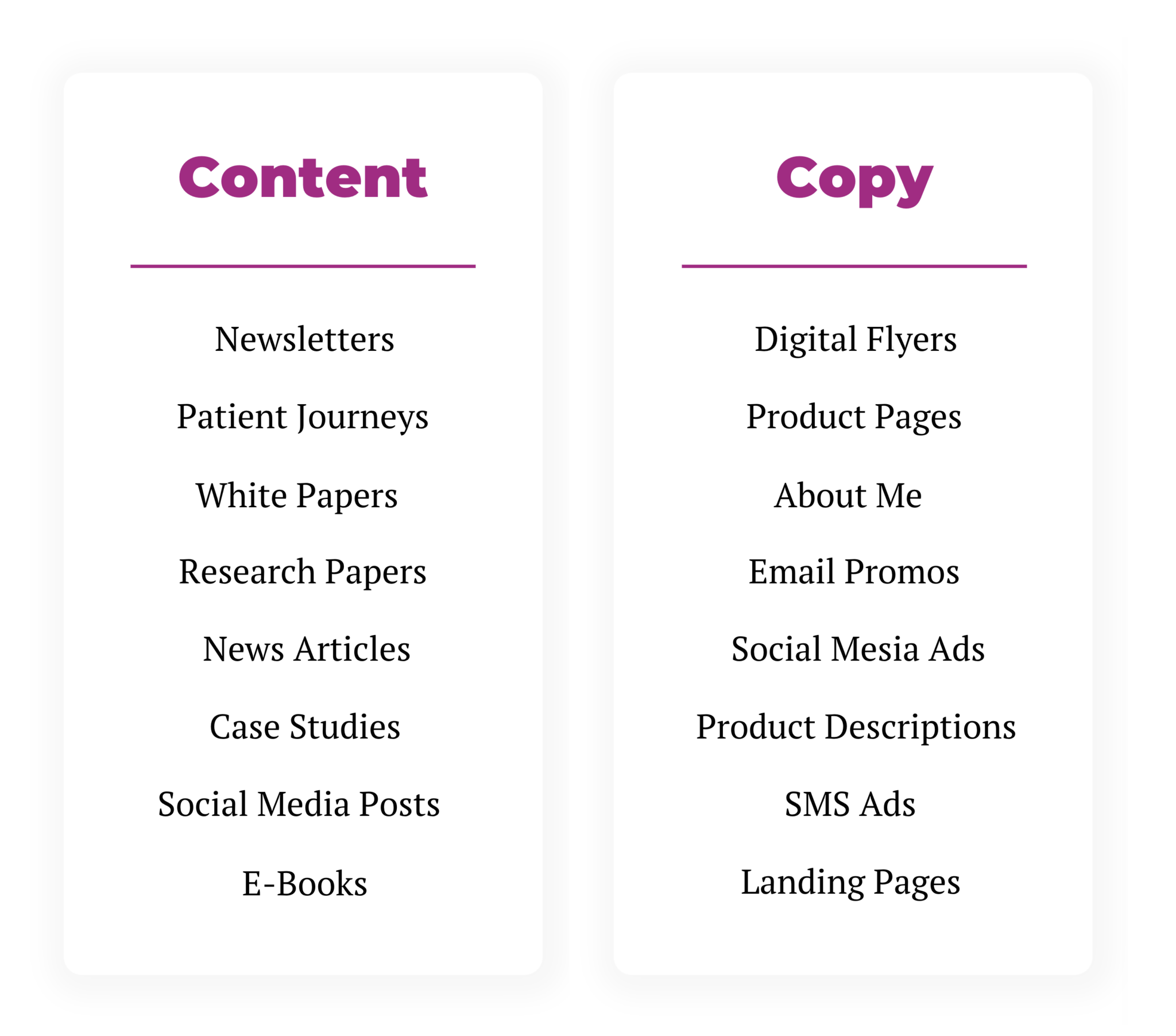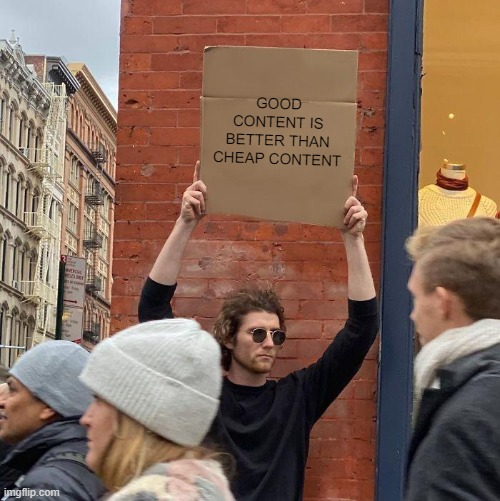Why? Because it sucks. Pardon our candor, but if your agency is outsourcing your medical content to a third party that isn’t specifically trained in the medical aesthetics industry, then your content isn’t as good as it should be. There are a lot of industries that can probably make use of this kind of mass-produced material with some success, but medical aesthetics isn’t one of them. Invest in an agency willing to invest in your content, and you will see firsthand the results it can bring.
Is it possible that the third party an agency is using will produce some good content occasionally? Sure. But most scientists agree that with enough time, even an ape hitting keys at random on a typewriter would be able to recreate the complete works of Shakespeare. It just depends on how fast your monkey is.

To be clear, we aren’t saying all writers are chimps or anything. (But if they were, Incredi-chimps would be the fastest in the west.)
Ape jokes aside, it isn’t about speed or dumb luck. Many aspects of your content program stand to excel (or fail) because of the knowledge of your writers. Let’s break down 7 of the most important.
1. Content Writing vs. Copywriting

To someone who doesn’t spend a lot of time thinking about all the different types of content, it can be challenging to understand the difference between content and copy. Even to the consumers for whom the writing is made, there might not be any difference between the two.
But there are, in fact, significant differences. And if your agency is outsourcing your medical content to writers who are not trained in both content and copy, then the product you receive might be subpar despite all the bananas you are investing. And yeah, we’re sticking with the primate theme.
Copywriting
You will hear the term “copy” thrown around pretty liberally in any setting that requires writers to produce writing. This broad definition is understandably pretty ubiquitous.
But in the marketing world, copy refers to very specific subsets of writing. Anything promoting a product or service, or anything that directly converts your patients, is referred to as “copy.”
If you are designing a landing page for an advertisement to get people to sign up for your services, you need copy for that page, not content. If you are writing the Google advertisement itself, that is also copy.
Digital flyers? Copy.
Product pages? Copy.
About me? Copy.
Email promos? Copy.
Social media ads? Copy.
Product descriptions? Copy.
SMS ads? Copy.
…Do you copy?
Content Writing
Content, on the other hand, is anything that looks to entertain or educate your patients or potential patients. Copywriting wants to persuade your audience; content writing intends to inform them.
Content is generally considered larger and written in a way that is more of a narrative experience. Well-designed blog articles are an excellent example of content over copy.
You might have a procedure page explaining the fundamentals of Botox and why a patient should consider it at your practice. And that is good fundamental copy.
But a blog could give them 13 reasons they should think about Xeomin instead of Botox at their next appointment. It might let them know how well you understand the difference between those two products and educate them on their options. The main goal here isn’t to sell but to build a trusting relationship with that patient. This is good content.
Content is like social anxiety. It’s everywhere, even if you don’t pay attention to it until it’s yours.
Newsletters? Content.
Patient Journeys? Content.
Tutorials? Content.
White papers? Content.
Research papers? Content.
News articles? Content.
Case studies? Content.
Social media posts? Content.
E-books? Content.
We’re all visual people, so here’s that same info, but in an ![]() infographic.
infographic.![]()

Why Knowing the Difference Is Important
It might seem like a no-brainer, but if you are getting content from someone who doesn’t understand the difference between these concepts in the medical aesthetics industry, then your marketing copy won’t be tailored correctly for what you are trying to achieve.
Have you ever tried to sell someone by making them read an entire ebook? No? Well, that’s for a good reason.
2. Knowing the Aesthetic Medical Industry

Finding something to say about Botox is pretty easy. It’s the most widely used, discussed and known cosmetic treatment in history. It wouldn’t be hard to drum up 500 words to slap down in an article and call it a day.
But is that 500-word, surface-level article going to perform well against the thousands of other articles? Nope. Not even close, baby.

When your agency outsources your content, you don’t know who is doing the writing and how well they know the medical industry.
They might not know that 57% of the wrinkle relaxers used in 2020 were on people between the ages of 40 and 54, but newer generations are beginning to use Botox as a preventative treatment rather than a reactive one.
They might not know about the recent history of BIA-ALCL associated with certain textured implants. And rather than spending the time to learn about it, they might just leave it out of your content entirely.

They might not know for a long time that Brazilian Butt Lifts were considered dangerous by the public because of unusually high death rates.
And the last thing you want to do when people are worried is write about how Brazilian Butt Lifts kill it when trying to improve your butt appearance — sure, we know it wasn’t meant negatively, but it might still be in bad taste.
Writers trained in the aesthetics field produce content that reflects the nuance of the industry.
If you let your agency outsource that content, there’s a strong chance you won’t seem like the knowledgeable, experienced and educated professional you are.
It’ll be like all those sleepless nights in med school never happened. (Shudder.)
3. Knowing Your SEO Needs

Content and SEO are like siblings who are less than a year apart. They bicker for hours about how to play a game, call each other names, run to mom to tattle-tell, and even duke it out with clumsy fisticuffs once in a while.

(For legal purposes, we are required to say that Incredible Marketing, Inc. strongly discourages resorting to physical violence to resolve content matters. Tattle-telling is fair game, though.)
In the end, though, the final game they end up with is all the better, thanks to the collaborative, lively effort.
The same is true for your content.
When it comes to your product, it’s a little less exaggerated. Often SEO and content needs align, especially in Google’s current form, and keeping the two departments together means no disconnect between the work being produced and your specific SEO goals.
When your agency handles your SEO internally and your content externally, it is difficult to hit the same level of collaboration you would get with an entirely internal team.
In some cases, agencies may even use the biggest no-no of all: content mills.
Content mills are websites where you can pay an almost unethically low cost to writers for quick and dirty content. They are efficient for some agencies to meet their raw word counts, but that content is cookie-cutter, surface-level information that won’t do much for your bottom line.

Unfortunately, because of the low prices charged, the writers available on these sites are experts at cranking out a few hundred uninspired words at a rapid rate to keep up their own margins. They also rarely have plagiarism or content uniqueness checkers — a big deal if you are trying to increase your SERP success.
Google EATs Bad Content
Surprise, surprise, Google has a big appetite. When you write medical content with a clear understanding of the procedures and best practices for communicating medical information, the authority of your content becomes much more substantial. Authority is a measurable metric that is used to determine your placement in the search engine page.
Not to mention, the methods by which you write best-case content for all of your collateral lends itself naturally to winning featured snippets (those little nuggets of gold that pop up before all the results) and voice search queries.
4. Knowing Your Audience

You spend a ton of time working with your patients. You meet them, get to know their symptoms, their fears, their hopes, goals, medical histories, life stories — over time, you get to understand the kind of patients who come to see you.
The same can be said for your writers. Over time, a dedicated medical writer will come to know the persona of the potential patients you are seeking. They know what the top queries are; they know what the conversations on forums like Reddit and Quora look like; they have seen, interviewed and written about the entire experiences of some of those patients as well.
In short, they know who your audience is.

Plastic surgery and all cosmetic medicine is a deeply personal journey. It deals with people’s biggest insecurities and fosters hope for their future. But as someone putting information into the world about this industry, you must be careful about how you present it.
You need to be wary your writers aren’t overselling what a treatment can achieve. False expectations are unfair to both you and your patients, and the last thing you want to do is lead someone to believe anything more than the achievable is, well, achievable.
You also have to be sensitive to the fact that your writer’s words have an impact. Many websites prey on the insecurities of people like your patients, and those words can have devastating impacts on their psyche.
Creators who aren’t used to the aesthetics industry won’t necessarily understand the impact of these nuances of these factors.
Here are some examples of how to approach aesthetic medicine content from a sensitive perspective:
| Procedure | Not Good | Better | Best |
|---|---|---|---|
| Breast Augmentation | Small breasts are a very noticeable aesthetic problem that throws your entire bodily contour out of balance. | Small breasts can throw off the balance of the rest of your body contour in some cases. | Increasing your breast size can provide some balance to the rest of your body contour if that is your goal. |
| Liposuction | Pockets of excess fat are displeasing to the eye and often make your appearance look flabby and untoned. | Unwanted pockets of fat can have some unwanted effects on the body and throw off your preferred contour. | If you prefer a slimmer contour, getting rid of unwanted fat can help improve your natural curves. |
| Botox | Wrinkles aren’t a good look for anyone. They make you look older and create unsightly folds throughout lax skin. | Wrinkles are inevitable and can add years to your physical appearance, making you look older than you actually are. | Wrinkles are a natural part of the aging process. But they can have adverse effects on your appearance, like making you look older than you feel. |
5. Capturing Your Voice

Not all medical professionals are created equally. And not all content should be made as though they were. Your content should reflect you as a person and as a professional.
If you are funny and lighthearted, that should be the voice you aim for. If you are more empathic and warm, the words that are used should illustrate that. If you are a stone-cold jerk… we might fudge the truth a bit for ya’ and soften those edges.

But how is a writer who has never interacted with you or your marketing team supposed to communicate that in your content? Notes are helpful, but the odds of your work getting outsourced to an entity that will take the time to get to know you personally is slim.
We don’t want to get all Ursula the Sea Witch on you, but capturing your voice effectively is something you need your marketing partner to do right. And allowing it to be outsourced to someone who has no idea who you are is not going to provide you with results.
6. HHS Best Practices … Sometimes

Speaking of not following best practices, let’s talk about medical writing in general. The Department of Health and Human Services has a ton of recommendations when it comes to communicating healthcare information to the general public.
One of the most pertinent to your marketing efforts is the idea of writing specifically for your audience. In marketing terms, this means understanding where they are in the funnel and knowing how to push them through to the next phase. But in content terms, this means understanding your audience’s reading and education level.
The HHS refers to this as plain language. And it’s actually a law for federal communication. Many organizations like the AMA and CDC recommend writing at no higher than an eighth-grade reading level since that is where most Americans fall.
But that might not be the case for your practice. If you serve a more educated clientele, you don’t necessarily need to worry about hitting that lower bar.
For example, at Incredible, we work with literal doctors. So you won’t see us lowering our reading levels anytime soon.

Conversely, if you are a medical professional in an underserved community, you might need to try making your most important information simpler than the eighth-grade benchmark.
Writers planted firmly in the aesthetics and medical industry understand these concepts. They know the best ways to communicate complex information to the public, simplify dense medical information and answer the questions patients are most likely to have.
Most importantly, though, they know when to follow those best practices and when to break them. In some cases, building your reputation as a knowledgeable professional is a higher priority than creating simple content.
When that’s the case, your writer needs to know the best places to ignore those HHS guidelines and give you the results you are after. The only way to know how to do that is to be a versed writer in the aesthetics industry.
7. Staying HIPAA With the Kids

Last but not least (especially legally), we have HIPPA concerns to consider. If you don’t want to get sued into the great beyond, having writers familiar with HIPAA and navigating its boundaries is paramount.
(Or AHPRA if you are from Australia, GDPR in Europe, UAE Healthcare law in the UAE, or our favorite sounding acronym yet, PIPEDA in Canada … yeah, we know those too. 💅)
Our writers have a deep understanding of the parameters to work within and have processes in place to remove patient identifiers, obtain patient consent well in advance and only use identifying information when necessary.

This includes communications on all channels: websites, social media, YouTube, TikTok, ads, emails, etc.
Writers familiar with this space know how to effectively use pseudonyms and reliably keep information both entirely factual and protective of the patient’s identity. These methods are particularly important when creating content like Patient Journeys, testimonials, before and after graphics, etc.
As of now, HIPAA names 18 identifiers that need to be absolutely protected by medical professionals:
- Name
- Address
- Dates
- Phone numbers
- Fax numbers
- Email addresses
- Social Security number
- Medical record number
- Health plan beneficiary number
- Account number
- Certificate or license number
- VINs or license plate numbers
- Device identifiers
- Web URLs
- IP addresses
- Finger/voice print
- Photos
- Other unique identifiers
If you’re having content problems, we feel bad for ya’ son. You got 18 problems, and HIPAA is pretty much all of them.
Hire Only the Best Apes

Not to pat ourselves on the back or anything, but our content is bananas. If you are worried that your copy or content is not hitting the right notes or falling short in any of the areas we covered, give us a call. We will help get you sorted out.
Our team is full of creative writers with years of experience in the aesthetic industry. They know what makes good content tick and how to apply it to your practice.
As usual, our educators are here to answer any questions you have, anytime, for free. Give us a call at (800) 949-0133 or schedule a one-on-one.




